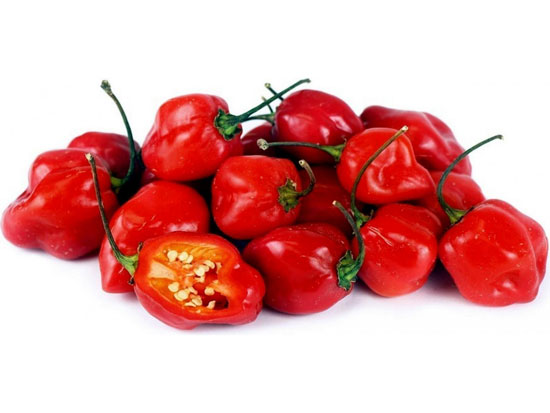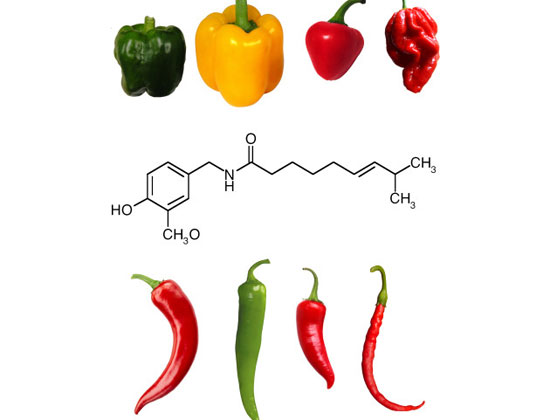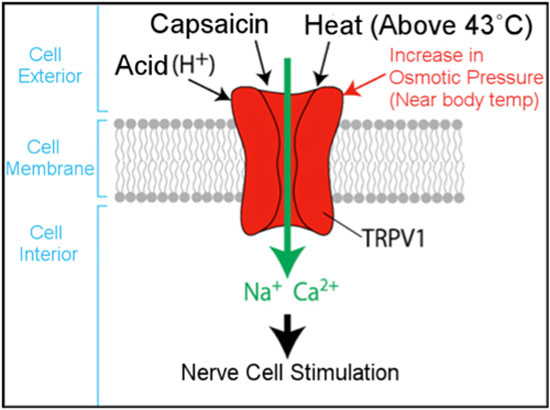Chili peppers could slow progression of lung metastasis
Capsaicin, responsible for the heat in chili peppers, was found to reduce metastasis in mice with lung adenocarcinoma. In vitro, capsaicin stopped metastasis by blocking the activation of a key protein that modulates the proliferation and motility of cancer cells.

Capsaicin is concentrated in the white part of the pepper lining the inside, called the placenta, not the seeds; however, the seeds may be coated with some of the oil. If you carefully remove this part of the pepper, it helps reduce the heat.
Past research demonstrated the effectiveness of capsaicin on breast cancer, colorectal cancer and small cell lung cancer; it also has anti-inflammatory and pain relief properties comparable to the nonsteroidal anti-inflammatory drug diclofenac.
Chili peppers positively affect your metabolism, reduce high insulin levels, support your heart health and may reduce your risk of Alzheimer’s disease.
Chili peppers are known for their hot flavor. They are primarily used as a spice in a variety of dishes and sauces. There are several species and cultivars of hot pungent peppers in the nightshade family.
Chili peppers are native to North and South America but are now cultivated in warmer climates around the world. Some of the more common cultivars include Cayenne, jalapeno, serrano and Thai chili peppers.
One of the hottest peppers in the world is the 7 Pot Douglah chili pepper, with a Scoville heat unit of 1.8 million, as compared to the more commonly used jalapeno peppers with a Scoville heat unit range of 2,500 to 8,000.
The heat of the pepper is ranked on a Scoville heat unit scale ranging from zero up into the millions, and is measured by how much sugar water is needed to dilute the spice of the pepper until you cannot taste the heat.
Capsaicin in Chili Peppers Brings the Heat
Chili peppers may be eaten fresh or dried and are often used to flavor hot curry, barbecue and other spicy sauces. Capsaicin is the bioactive plant compound responsible for the hot and spicy kick. The compound is concentrated in in the white part located inside the pepper, and not in the seeds.
This area, called the placenta, may be removed to reduce the heat of the pepper. Pepper seeds may also be coated in some of the oil, so removing the seeds will also help to remove heat.
The chili pepper belongs to the nightshade family Solanaceae. This family of fruits and vegetables include some toxic plants, including belladonna, also called deadly nightshade. Others, however, are commonly grown and eaten, including tomatoes, eggplants, white potatoes and cayenne pepper.
The burning sensation capsaicin imparts is not actually a taste. Rather, it’s caused by a stimulation of nerves sending two messages to the brain of intense stimulus and warmth. The burning sensation is due to the combination of these two messages.
Capsaicin May Reduce Lung Cancer Metastasis
Capsaicin is associated with a reduction in the spread of lung cancer. Results of a study were presented during the 2019 Experimental Biology meeting held in Orlando, Florida. The researchers were interested in evaluating the ability of capsaicin to reduce metastasis in lung adenocarcinoma, which accounts for the majority of all non-small cell lung cancers.

According to the researchers, a substantial number of patients with lung adenocarcinoma presented with local and distant metastasis by the time they were diagnosed. The researcher’s long-term goal was to identify nutrition-based strategies to suppress the growth of metastasis of several types of cancers, including melanoma, prostate cancer and cholangiosarcoma.
Using mice, they compared the antimetastatic activity of capsaicin against two other natural nonpungent capsaicin-type compounds, capsiate and capsiconiate. The application of capsaicin had been shown to induce apoptosis in cancer cells in earlier studies. Still, the researchers believed the clinical use of capsaicin was limited due to an ‘unpleasant side effect profile.’
The researchers tested capsaicin on three cultured lines of human non-small cell lung cancers and fed mice with lung cancer a diet enhanced with capsaicin. They found the mice consuming a diet with capsaicin had a smaller number of metastatic cells compared to those that did not receive the treatment.
Further in vitro experimentation led to the discovery that capsaicin stopped metastasis by blocking the activation of a key protein regulating the proliferation and motility of cancer cells, the Src protein. Lead author, Jamie Friedman, Ph.D., commented:
‘Lung cancer and other cancers commonly metastasize to secondary locations like the brain, liver or bone, making them difficult to treat. Our study suggests the natural compound capsaicin from chili peppers could represent a novel therapy to combat metastasis in lung cancer patients. We hope one day capsaicin can be used in combination with other chemotherapeutics to treat a variety of lung cancers.’
Past Research Shows Capsaicin Reduces Other Cancer Risks
This was not the first study to demonstrate the potential capsaicin has against cancer. Breast cancer is one of the most prevalent forms of cancer in women around the world. In 2018 there were over 2 million new cases globally, according to the American Institute for Cancer Research.
A research team from Germany studied the effects of capsaicin against transient receptor potential channels known to contribute to the regulation of intracellular calcium and promote cancer. Using breast cancer tissue samples of an aggressive breast cancer subtype, researchers found capsaicin reduced these signals and caused significant inhibition of cancer cell growth.
Research has also evaluated the effect capsaicin has on human colorectal cancer cells in vitro. Researchers found capsaicin treatment decreased enzymatic levels, suggesting capsaicin may be useful against colorectal cancer. Another study found capsaicin targets multiple signaling pathways and tumor suppressor genes.
The American Cancer Society estimates the number of colorectal cancer cases in the U.S. in 2019 will be 145,600. The overall lifetime risk is approximately 1 in 22 for men and 1 in 24 for women. In the U.S., colorectal cancer is the third leading cause of cancer-related deaths and the second most common cause of cancer deaths when men and women are combined.
While the featured study looked at lung adenocarcinoma of non-small cell type, past research has evaluated the effect of capsaicin against small cell lung cancer in vitro and in vivo. Researchers found, taken together, their data provided insight into the mechanism underlying the apoptotic activity of capsaicin and offering further avenues of study.
Capsaicin Has Anti-Inflammatory and Pain Relief Properties
Capsaicin is a potent inhibitor of substance p, a neuropeptide researchers have found is associated with an inflammatory process. It works by depleting your sensory nerves of substance p and then interferes with the perception of pain.
The hottest varieties easily accessible at the market are habanero and Scotch bonnet peppers. Jalapenos are next in line on the Scoville heat index, followed by Spanish pimentos, Anaheim and Hungarian cherry peppers.

In an animal study evaluating analgesic effects, researchers compared capsaicin against the anti-inflammatory effect of nonsteroidal anti-inflammatory drugs (NSAIDs), finding capsaicin produced anti-inflammatory effects comparable to the NSAID diclofenac.
In another study, researchers found the effect induced by capsaicin may be the result of inhibition of proinflammatory cytokine production. Studies evaluating the use of capsaicin with osteoarthritis have also demonstrated positive results.
In one study, 80% of those treated with capsaicin experienced a reduction in pain after two weeks. In another, topical capsaicin treatment was found to be effective in reducing intensity regardless of the site of application and dose in those with moderate pain. The treatment was found to be safe and well-tolerated.
Chili Peppers May Support Your Immune System and Heart Health
Bright red chili peppers have a high beta carotene content. According to WH Foods, just 2 teaspoons provide 6% of your daily recommended dose of vitamin C, and more than 10% of vitamin A. Vitamin A is vital to the health of the mucous membranes lining your nasal passages, lungs and intestinal tract.
Capsaicin supplementation may also reduce your risk of coronary heart disease (CHD). In one study, researchers evaluated the effects of capsaicin on serum lipid profiles in those who had low high-density lipoprotein (HDL).
Using a randomized, double-blind, controlled clinical trial with 42 participants, half were assigned to take capsaicin daily while the other served as the control group. Those in the experimental group experienced a reduction in triglycerides and C-reactive protein.
Capsaicin appeared to improve risk factors in those who had low HDL and the researchers concluded it may contribute to the prevention and treatment of CHD.
Another study published in the American Heart Association journal Circulation, found those using an over-the-counter pain salve with capsaicin could reduce damage to the heart during a heart attack. Keith Jones, Ph.D., a researcher on this study, commented:
‘Both this and the capsaicin effect are shown to work through similar neurological mechanisms. These are the most powerful cardioprotective effects recorded to date. This is a form of remote cardioprotection, using a skin stimulus that activates cardioprotection long before the blocked coronary artery is opened.’
Chili Peppers Affect Your Metabolism and Cognitive Function
Eating hot food requires a greater amount of energy and produces an increase in thermogenesis and oxygen consumption for more than 20 minutes after eating. In one study, researchers found a 20.5% negative energy balance after consuming 2.56 milligrams of capsaicin per meal. This promoted fat oxidation and did not increase blood pressure significantly.
In a meta-analysis, researchers assessed whether chili pepper consumption might reduce body weight. One of the prospective studies included in the analysis investigated the effects on energy intake, indicating the addition of red pepper at breakfast decreased protein and fat intake at lunch and significantly reduced carbohydrate intake during lunch.
Overall, they concluded capsaicin plays an important role in metabolic health, especially for weight loss in those who suffer from obesity. Lowering the risk for obesity may also reduce your risk factors leading to Type 2 diabetes. Additionally, chili peppers may help with blood sugar level management. One study concluded regular consumption helps reduce risk of high insulin levels.
Capsaicin was also shown to reduce Alzheimer-associated changes in the hippocampus of diabetic rats. The results demonstrated that dietary capsaicin prevented Alzheimer disease-associated tau protein formation and may have a potential use in the prevention of Alzheimer’s disease in diabetics.
A second study also conclude ‘a capsaicin-rich diet may exert favorable effects on [Alzheimer’s disease] blood biomarkers and cognitive function in middle-aged and elderly adults.’
Yet another animal study used extracts of red pepper and found it prevented memory deficit and exacerbation of insulin resistance in diabetic rats, suggesting capsaicin may be an effective intervention for preventing age-related memory deficit.
Using Chili Peppers in the Kitchen

Chili peppers have an impressive number of health benefits, including adding zest and heat to your spicy foods. They may be dried, powdered (paprika) or eaten fresh from the garden.
Chili pepper plants are relatively easy to plant and care for, and their brilliant red or dark green color is a beautiful addition to your flower or vegetable garden. If you don’t have room in your own garden, your local farmer’s market will keep you stocked.
yogaesoteric
January 16, 2020

